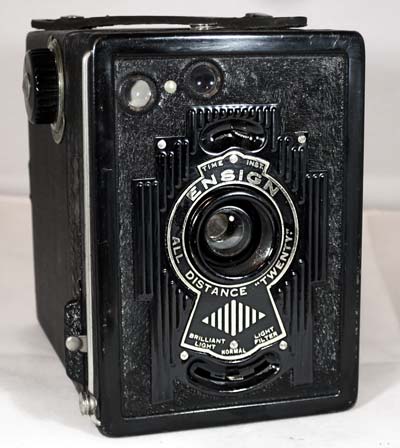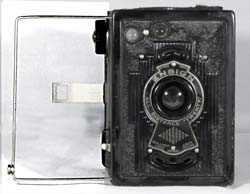Ensign All Distance "Twenty"
Specification

| Manufacturer | : | Houghton-Butcher |
|---|---|---|
| Produced | : | 1936 |
| Classification | : | Medium Format |
| Body Type | : | Box |
| Construction | : | Metal |
| Film Type | : | 120 |
| Film Width | : | 62mm |
| Image Size | : | 2¼ x 3¼ in |
| No. of Images | : | 8 |
| Lens Type | : | Meniscus |
| Focus Type | : | Fixed |
| Focal Length | : | 105mm |
| Focus Range | : | 6 to 10ft and 10ft to inf. |
| Aperture Type | : | Two stops plus yelow filter. |
| Aperture | : | f/16; f/22 |
| Shutter Type | : | Rotary |
| Shutter Speeds | : | B,I*(1/40 sec) |
| Size (w x h x d) | : | 82 x 110 x 123 mm |
| Weight | : | 594g |
| * Measured on this camera | ||
Art Deco Credentials
![]()
![]()
![]()
![]()
Significant: Pronounced and self evident
- Produced during the main Art Deco period;
- Stepped ribbed design on front plate;
- Black enamel front plate with chrome highlights;
- Chevron pattern on body covering
Description
The Ensign All Distance "Twenty" comes in many guises and was produced from about 1927. However, in 1936 an Art Deco version was produced which took its design from the prevailing style. It is of metal construction and partially covered in leather-cloth with a chevron design embossed in it. It used an attractive cracked paint on other parts. 'MADE IN ENGLAND BY THE HOUGHTON-BUTCHER MFG.Co.LTD LONDON' is imprinted on the back of the camera. It produces 8, 2¼ x 3¼ inch exposures 120 roll-film.

The meniscus lens has two stops and a yellow filter. A tab below the lens allows the two stops and the filter to be swung into place behind the lens. The left hand position (looking at the camera) is marked 'Brilliant Light' (f/22). The centre position is marked 'Normal' (f/16) and the right hand position is marked 'Light Filter'. The yellow filter is often used to produce more contrast between clouds and blue sky. The lens can be pulled out for close distance focussing. With the lens in, subjects further than 10ft are in focus. With the lens out then subjects closer than 10ft are in focus. The shutter has both T & I settings with the instant speed being about 1/40s. The time setting is more like 'bulb'. The shutter lever is protected somewhat by a protuberance next to it.
Framing can be carried out, either by using the two brilliant view-finders, or by the pull out direct vision viewfinder that is composed of a wire frame at the front and a back sight. Film advance is indicated by red window which should be covered when using modern film. It has a nice leather strap. It is fairly easy to clean as the front can by carefully prized off with a thin blade which gives access to all the glass and mirrors.
How to Use
The manual for a similar camera is found here:- Ensign All Distance Twenty Manual
This camera takes 120 film which is easily available. Don't forget to cover the red window with black tape and only open it when advancing the film in low light conditions.
As the shutter speed is only 1/40s, it is advisable to use a tripod to get clear shake free images. However, holding it against a wall or other solid object would work as well. For quick snapshots, hold it firmly against your body.
If you don't want to bother with an exposure meter, follow the guide shown. It is based on the 'Sunny 16' rule. Film is so forgiving and will produce acceptable results even when overexposed by 2 or 3 stops or underexposed by 1 stop.
The tables assume that the sun is at least 30 degrees above the horizon - that's 10am - 5pm on a summers day (May - August) in the UK.
Remember that the exposure guide in the manual may not be helpful as it is based on the use of old film with a low ISO value.
Using ISO 100/125 film - shutter speed 1/40s
| Weather Conditions | Shadow Detail | Aperture | Exposure |
|---|---|---|---|
 Sunny SunnySnow/Sand | Dark with sharp edges | f/22 | +1 Stop Overexposed Acceptable |
 Sunny Sunny | Distinct | f/22 | Good |
 Slight Overcast Slight Overcast | Soft around edges | f/16 | Good |
 Overcast Overcast | Barely visible | f/16 | -1 Stop Underexposed Acceptable |
 Heavy Overcast Heavy Overcast | None | f/16 | -2 Stops Underexposed Not Acceptable |
 Open Shade Open Shade/Sunset | None | f/16 | -3 Stops Underexposed Not Acceptable |
Photographs taken with this Camera
Using Kodak Portra 160 film. Developed in Tetenal.



